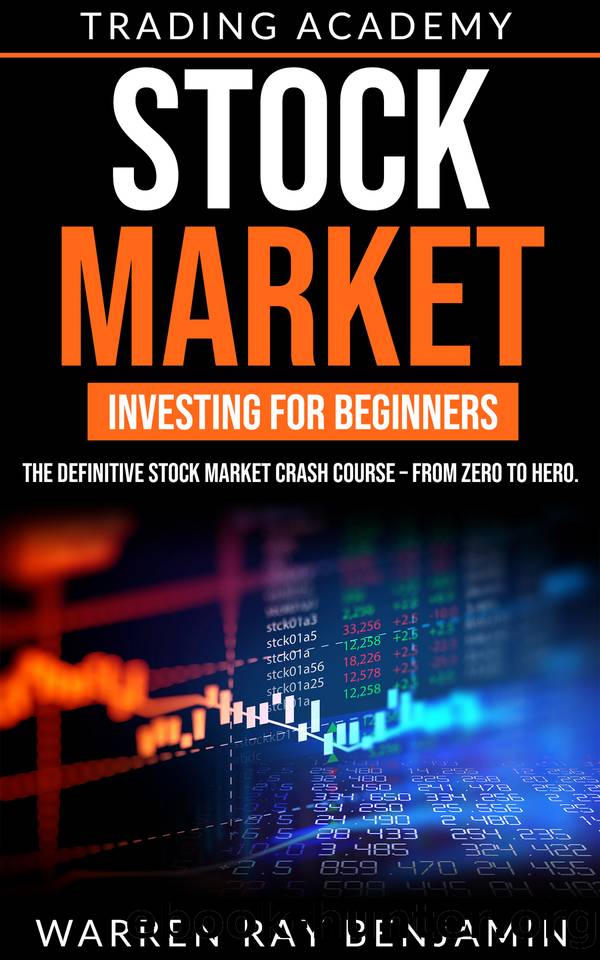Stock Market Investing for beginners: THE DEFINITIVE STOCK MARKET CRASH COURSE â FROM ZERO TO HERO. by Benjamin Warren Ray

Author:Benjamin, Warren Ray [Benjamin, Warren Ray]
Language: eng
Format: epub
Published: 2021-01-05T16:00:00+00:00
Chapter 11-
What Is Expense Ratio?
The expense ratio, also is known as the management expense ratio, represents all recurring annual expenses. The management expense ratio includes the hiring cost, the investment manager, administrative costs, and the 12b-1 fee. The cost of hiring an investment manager ranges between percentages of 0.5% to 1%. Although this may be a small percentage, it can amount to millions if the fund is substantial. However, investors must not believe that a high fee equates to better fund performance. Administrative costs include customer service, record-keeping, postage, etc. There are mutual funds that minimize these costs. However, not all of these funds are excellent in keeping the costs down. Finally, the 12b-1 fee in the United States of America is a recurring cost. It pays for promotions, advertising, and broker commissions. In general, an index fund only has an expense ratio of 0.2%, while the average expense ratio of an equity mutual fund can go up to 1.5%. An international fund or specialty fund charges a higher expense ratio because these finds require a highly experienced fund manager.
This is by far the highest cost that you need to calculate. The expense ratio calculates the cost of running a mutual fund. All mutual funds charge a fee, often known as an operating expense or management fee. No matter how your fund institution refers to it as it is the primary determinant of your take-home money.
This fee is a deduction of the total assets of a fund before determining the share price. For instance, if your mutual fund has a value of $15 per share with a gross return of 10%, then its total investment return will be $1.5 per share. The fund share would be valued at $16.5 if there was no fee. However, the fund manager will deduct a 1% fee, so your ROI would be $1.34 instead of the complete $1.5. Hence, the total worth of your share will be $16.34.
â Funds that are actively managed charge higher operating costs compared to an index or passive funds since they require continuous research and assessments. Many financial experts claim that not all active research justifies the returns; hence, you end up paying more.
â Compared to domestic funds, international funds charge higher fees since it costs more to invest in opportunities abroad.
â Small-cap funds also have higher fees since it costs more to purchase and sell smaller stocks than it costs to sell higher costs.
â The costs also vary from company to company. Two companies offering the same types of funds might have different fee structures due to other related variables and policies.
â An ideal low expense ratio is considered anything between 0.5% and 0.75% for a portfolio that is actively managed. A high expense ratio would be anything above 1.5%.
â Passive funds or index funds have comparatively the lowest fees and could be anything around 0.2%. These are also considered the most lucrative ones in the long run.
All these factors and fees significantly impact the overall expense ratio of a fund.
Download
This site does not store any files on its server. We only index and link to content provided by other sites. Please contact the content providers to delete copyright contents if any and email us, we'll remove relevant links or contents immediately.
Pioneering Portfolio Management by David F. Swensen(5606)
Rich Dad Poor Dad by Robert T. Kiyosaki(5149)
How To Win Friends and Influence People by Dale Carnegie(3771)
The Money Culture by Michael Lewis(3284)
The Dhandho Investor by Mohnish Pabrai(3168)
The Wisdom of Finance by Mihir Desai(3078)
Liar's Poker by Michael Lewis(2811)
The Intelligent Investor by Benjamin Graham Jason Zweig(2596)
The ONE Thing by Gary Keller(2519)
Mastering Bitcoin: Programming the Open Blockchain by Andreas M. Antonopoulos(2511)
Investing For Dummies by Eric Tyson(2470)
How to Day Trade for a Living: Tools, Tactics, Money Management, Discipline and Trading Psychology by Andrew Aziz(2445)
How to Win Friends and Influence People by Dale Carnegie(2435)
Rich Dad Poor Dad: What The Rich Teach Their Kids About Money - That The Poor And Middle Class Do Not! by Robert T. Kiyosaki(2434)
Fooled by Randomness: The Hidden Role of Chance in Life and in the Markets by Nassim Nicholas Taleb(2413)
Zero Hour by Harry S. Dent Jr. & Andrew Pancholi(2246)
Market Wizards by Jack D. Schwager(2163)
Rich Dad's Guide to Investing by Robert T. Kiyosaki(2111)
How to Pay Zero Taxes, 2018 by Jeff A. Schnepper(2099)
